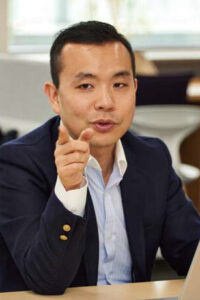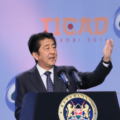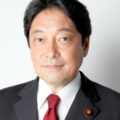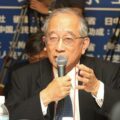Promoting Japan–South Korean Cooperation and Broadening Empathy: Taking as a Clue the Question of a Japanese Diplomat
There is a gap between Japan and South Korea that is emotionally difficult to bridge. Sunobe Ryozo (1918–2006), who served as Ambassador to South Korea forty years ago, has said that the state of Japan–South Korea relations is a “litmus paper” for Japanese growth. At present, having common values and social issues really is a step toward overcoming the “emotional gap” over historical perceptions.
Kobayashi Somei, Associate Professor, Nihon University

Prof. Kobayashi Somei
Forty years ago, there was a Japanese diplomat who asked what South Korea is to Japanese diplomacy. It was the then Ambassador to South Korea Sunobe Ryozo, who later also served as Vice-Minister for Foreign Affairs. In a declassified confidential telegram titled “Report and Views on Circumstances within the Ministry’s Jurisdiction as well as Policy Proposal” (hereinafter, the “Sunobe Proposal”) to the Ministry of Foreign Affairs (MOFA) in January 1981, Sunobe wrote that “It goes without saying that South Korea is not the be-all and end-all of Japanese diplomacy,” but also that “For all of Japan—not MOFA but also including the government and the private sector—that relationship with South Korea, whether or not it is going well, really is a litmus paper for seeing how much Japan has grown internationally” and that “It could be said that it is only when Japan–South Korea relations become trouble-free that Japan will mature into being ‘Japan in the world.’”
What kind of answer can we find for Sunobe’s question today in 2020? Moreover, will the litmus paper react with the color that signifies maturation? This paper takes the “Sunobe Proposal” as its clue to suggest one possibility for resolving the current situation of worsening Japan–South Korea relations and starting to build a relationship of cooperation.
“Understanding the Undercurrent and the Emotional Gap” as the Basics of Our Korea Policy
The “Sunobe Proposal” consists of seven items (“Understanding the Undercurrent and the Emotional Gap,” “Understanding Korea(ns) from Diverse Perspectives,” “The Kim Dae Jung Issue,” “(Korean) Economic Recovery,” “The Issue of South (and North) Korean Residents in Japan,” “Promoting Understanding of Japan,” “The Issue of Cultural Cooperation”). In “Understanding the Undercurrent and the Emotional Gap,” Sunobe argued that “The basics of our Korea policy is that [the Japanese] create trust by also considering the Koreans’ situation or at least making the effort to try to understand it.” What kind of “situation” are we to consider and what are we to “understand”? This is what Sunobe first explains based on the historical context.
“The undercurrent of harsh feelings toward Japan that took root during the colonial period—some would argue it goes back to the Bunroku War (Imjin Waeran) (1592–1598) or even further back—still has not changed today. As many years as the colonial period lasted have gone by since Korean independence, so is it not time to write it off? That is the Japanese argument. From the Korean viewpoint, the thirty-six years of the Japanese Imperial period (1910–1945) were a period of indescribable sacrifices and humiliation. By contrast, what has Japan done for Korea in the thirty-six years that followed? I think their answer would be that we have been more or less idle.”
The Koreans’ “anti-Japanese sentiment” has its origin in the historical relationship between Japan and the Korea and it was still there in the early 1980s. Sunobe pointed out that there had appeared an “emotional gap” between Japanese and Koreans because of different perceptions of the colonial period and identified three factors needed to resolve it. The first is the passage of time. Sunobe expressed this as “spending time to pardon faults [to improve relations].” The second is economic assistance for “greatly reducing the economic disparity between Japan and South Korea.” The third is the Japanese attitude toward South Korea and he gives the following explanation about this.
“What I believe we should do is take a straight look at the reality of this undercurrent [my note: of anti-Japanese sentiment], be understanding of the Korean people’s sense of frustration [the flipside being envy toward Japan] with regard to the current state of their nation that has been forced into north–south division that prevents democratization and restricts economic development due to the heavy military expenses, and engage with the difficulties of our neighbors more magnanimously.”
Sunobe pointed out the importance of being “more magnanimously” “understanding” of Korean envy toward Japan, which stems from anti-Japanese sentiments caused by colonial rule and inhibited economic development due to the north–south division, as well as of the “circumstances” of the Korean people in the historical relationship with Japan and the Cold War era. Sunobe’s claim and advice was that the resolution of the “emotional gap” through these three factors could open up a new future for Japan–South Korea relations and that precisely this is the “basic policy toward South Korea.”
Effectiveness and Limitations of the “Basic Policy toward South Korea”
When considering Japan–South Korea relations at present, what effectiveness and limitations will this “basic policy toward South Korea” suggested in the “Sunobe Proposal” have? Let us take a look at it based on the three factors identified by Sunobe. Firstly, there is the factor of time. An emotional antagonism over the past persists between Japan and South Korea to this day. It highlights the limitations of Sunobe’s claim that the “emotional gap” rooted in the historical relationship between Japan and the Korea will be resolved in time.
Secondly, there is the economic assistance. If you were to ask whether providing economic assistance to South Korea, now with the world’s 12th highest GDP (2018), would resolve the Koreans’ “feeling of frustration” and “envy toward Japan,” the answer would likely be no. Despite updating the licensing policies and procedures on exports of controlled items to South Korea, this does not seem to have caused any changes to South Korea’s Japan policy but rather intensely stimulated Koreans’ anti-Japanese sentiments, making Japan–South Korea relations even more troubled. Perhaps it would have been possible in the 1980s, but the viewpoint that economic power can effect any kind of influence over Japan–South Korea relations today is naturally limited.
Thirdly, there is the stance of considering and “understanding” their “situation.” Understanding Korean feelings from the two perspectives of colonial rule and north–south division as well as earning their trust is something that would likely contribute not only to diplomacy but also the comprehensive development of Japan–South Korea relations, including private exchanges. Important here is the gaze on South Korea that can be sensed in the words of engaging “more magnanimously.” This in no way secures an equal relationship between Japan and South Korea but it rather has embedded a vertical sense. This is also inseparable from how the old image that “Japan ought to be important to South Korea” still exists in Japan today. Meanwhile, the view that the previously vertical relationship between Japan and South Korea is becoming horizontal is gaining credence in South Korea. Amid this, a gaze on South Korea that is not predicated on equal relations will likely cause great injury to the effectiveness of considering and “understanding” the Korean “situation.”
To earn the trust of Koreans by considering and “understanding” their “situation.” This has not yet lost its significance but is effective. Yet is it really possible to resolve the “emotional gap” that lies beyond that? Will it not turn into chasing after the “bluebird of happiness”? I have two reasons for thinking so. Firstly, it might be possible to shrink the “emotional gap” that Sunobe speaks of, which is an emotional discrepancy, but not to resolve it completely. This is because the feelings on either side are built on each side’s “justice” and the differences in “justice” are naturally causing an emotional discrepancy. Under these circumstances, as long as each side’s “justice” takes the form of correcting the other side’s “injustice,” it will be difficult to completely resolve the “emotional gap.” Secondly, there is a variety of discrepancies between Japan and South Korea, not limited to the emotional. Besides the historical perception issue, discrepant strategies about peacebuilding in East Asia, including the North Korean denuclearization process, and discrepant perceptions of the Cold War that support the former are all causing major turmoil in Japan–South Korea relations. Even if the “emotional gap” is completely resolved, the discrepancies in Japanese and South Korean strategies and perceptions are big impeding factors to the development of Japan–South Korea relations.
However, even though Japanese and South Korean strategies and perceptions differ, this does not mean that “Japan–South Korea relations [cannot] develop without trouble.” Of course, it is difficult to find a “wonder drug” that can fix the current worsened situation in one fell swoop. However, despite discrepancies in strategies and perceptions, it is still possible to build a relationship of cooperation between Japan and South Korea. Building a cooperative relationship can become the beginning of improving these worsened Japan–South Korea relations as well as contribute to developing and making more concrete the future vision for Japan–South Korea relations that was drawn up in the Japan–South Korea Joint Declaration of 1998 based on the “1965 system” (Treaty on Basic Relations between Japan and the Republic of Korea). It can become a resource for “maturing Japan into ‘Japan in the world.’” So, what is the best way to build and promote a cooperative relationship? I want to consider the possibility of empathy as an aid.
Toward Possible Empathy and a Future of Japan–South Korea Cooperation
Although there are discrepancies in strategies, perceptions, and emotions between Japan and South Korea, we do share basic values about what kind of society is desirable. Examples are democracy, respect for human rights, healthy and cultural lifestyles, and freedom of speech. That we share such basic values means that citizens of Japan and South Korea share not only direction toward the desirable society but also worries. Japan and South Korea have social problems in common, including human rights issues, discrimination, environmental problems, medical care, an aging population, and a decreasing birthrate, and both worry about these and make efforts to overcome them. Even if Japan and South Korea have different emotions, strategies, and perceptions, they can sympathize with each other as people who have such worries.
Empathy does not necessarily mean agreeing with the other side’s perceptions, ideas, and emotions, but is about a shared sense of what is important and what ought to be emphasized. Rather than aiming to detect and resolve “gaps” between Japan and South Korea, it is important to discover the challenges we share and spread empathy that is not dependent on agreement. Also when it comes to historical perception issues like the former civilian worker issue and the comfort women issue, this empathy between the Japanese and South Korean peoples can become a powerful support to resolve them.
Empathy becomes a driving force that makes possible the sharing of insights and engagement with the social issues that are the “common enemies” of Japan and South Korea. This conjures up a vision of Japan and South Korea advancing from mutual understanding to an age of collaboration. Such understanding and work will deter exclusive nationalism that widens the “emotional gap.” It will also increase the possibility of shrinking the “emotional gap.” It is already possible to observe several sites of collaboration between Japan and South Korea. As the novel coronavirus is spreading across the world, the two countries are working together to bring home Japanese and South Korean citizens who live abroad.
Japanese and South Korean media outlets also report about such collaboration favorably. The young generations in both countries are engaging in many intellectual conversations on themes like what kind of society we will live in and what kind of world we are aiming for. This kind of conversation-based collaboration between young people in Japan and South Korea to design East Asia and the world of the twenty-first century and to contribute to humanity is happening on all levels. Moreover, advanced medical cooperation, including big data use and analysis in R&D for cancer treatments, is also steadily being promoted. Important here is that Japan is not providing assistance to South Korea like in the past but that a cooperative relationship is being built where the two work with each other bilaterally.
This cooperative relationship permeated by empathy must be advanced steadily regardless of what administrations come into being in Japan and South Korea. In the South Korean general election that was conducted on April 15, 2020, the ruling party won a landslide victory and the foundation of the Moon Jae-in administration was solidified. In Japan, there is a widespread opinion that President Moon’s stance on Japan has not changed and that it is difficult to improve Japan–South Korea relations. There are also worries that the Koreans might liquidate the assets they seized from Japanese companies, and if they are liquidated, it is extremely likely that Japan–South Korea relations will break down. However, even if they are not liquidated and the situation is avoided, it will probably prove difficult to extract the thorn called “history” from Japan–South Korea relations. It should not be up to one of the two to extract this thorn, but it is necessary for the two to work together and collaborate to pull it out. In order to do so, it is important to overcome the “emotional gap” over historical perceptions, spread empathy in both societies based on a social awareness that reconciliation needs to be realized, and share a sense of the past and intentions for the future. As regards the historical perception issue, the “basic policy toward South Korea” of considering and “understanding” their “situation” as discussed by Sunobe still has not lost its effectiveness. Nonetheless, we should not engage “more magnanimously” based on an old image of South Korea, but there is a need for an attitude of facing contemporary South Korea after upgrading our understanding of them. Even if you do not like the other party and cannot agree with their claims, ensuring both sides’ willingness to resolve common issues and realizing a better society is something that will cultivate empathy in both. Such empathy will contribute to the overcoming of many social challenges common to Japan and South Korea, not restricted to the historical perception issue, and will give power to unshakeable development of Japan–South Korea relations that is not affected by the characters of the administrations.
What is South Korea to Japanese diplomacy? It might be difficult to find an answer to this question right now. Yet, an important process for finding that answer is my repeated question about what values and social challenges we share as well as building up a track record of cooperation little by little while affirming what kind of empathy buds and is being fostered. Likewise, communicating this track record of cooperation between Japan and South Korea to the world is an important “reagent” for telling us what color the litmus paper reacts with. My hope is for Japanese diplomacy to foster this empathy both in Japan and abroad as well as purchase a full set of such “reagents.”
Translated from “Nikkan kyoryoku no suishin to kyoukan no kakudai: Aru nihonjin gaikokan no toi wo tegakaritosite (Promoting Japan–South Korean Cooperation and Broadening Empathy: Taking as a Clue the Question of a Japanese Diplomat),” Gaiko (Diplomacy), Vol. 61 May/Jun. 2020, pp. 130-135. (Courtesy of Toshi Shuppan) [August 2020]
Keywords
- Kobayashi Somei
- Nihon University
- Japan–South Korea relations
- Sunobe Ryozo
- Sunobe Proposal
- emotional gap
- anti-Japanese sentiment
- “Basic Policy toward South Korea”
- former civilian worker issue
- comfort women issue
- cooperative relationship




